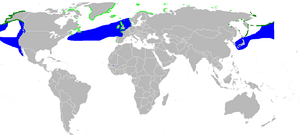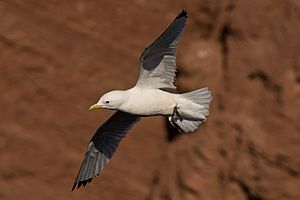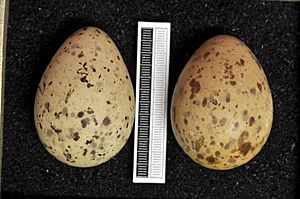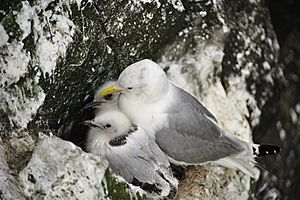Black-legged kittiwake facts for kids
Quick facts for kids Black-legged kittiwake |
|
|---|---|
 |
|
| Conservation status | |
| Scientific classification | |
| Genus: |
Rissa
|
| Species: |
tridactyla
|
 |
|
| Range of R. tridactyla Summer range Wintering range | |
| Synonyms | |
|
|
The black-legged kittiwake (Rissa tridactyla) is a type of seabird that belongs to the gull family. It's known for its unique call, which sounds like "kittee-wa-aaake."
This bird was first described in 1758 by a famous scientist named Carl Linnaeus. The name Rissa comes from an Icelandic word for this bird. The word tridactyla comes from Ancient Greek and means "three-toed." This is because these birds have a very small or missing back toe.
In North America, people call it the black-legged kittiwake to tell it apart from the red-legged kittiwake. But in Europe, it's often just called the kittiwake.
Contents
Where Do Kittiwakes Live?
The black-legged kittiwake lives along the coasts of the Arctic and subarctic regions. You can find them across the northern Atlantic Ocean, from Canada to Greenland. They also live on the Pacific Ocean side, from Alaska to Siberia.
In winter, they travel further south. This includes areas from the St-Lawrence River to New Jersey in North America. They also go to China, the Sargasso Sea, and off the coast of West Africa.
There are two main types, or subspecies, of black-legged kittiwakes:
- Rissa tridactyla tridactyla: Lives on the Atlantic coast.
- Rissa tridactyla pollicaris: Lives on the Pacific coast.
Kittiwakes are mostly found at sea, far from land. They only come to land to breed, usually from May to September. During this time, they build nests on tall sea cliffs. For the rest of the year, they spend almost all their time flying over the ocean.
What Do Kittiwakes Look Like?
Adult Birds
Adult kittiwakes are about 37 to 41 centimeters (15 to 16 inches) long. Their wings can spread out to 91 to 105 centimeters (36 to 41 inches). They weigh between 305 and 525 grams (11 to 18 ounces).
They have a white head and body, with a grey back. Their wings are grey with solid black tips. They have black legs and a yellow bill. Sometimes, their legs can be pinkish-grey or reddish. This can make them look a bit like the red-legged kittiwake.
A special feature is the bright red color inside their mouth. This color comes from things they eat. Studies show that a bright mouth color might help male birds find a mate. This is why pairs often open their mouths to each other when they meet. As their name tridactyla suggests, they have only three toes. Their back toe is either very small or completely missing.
In winter, adult kittiwakes get a dark grey smudge behind their eyes. They also have a grey band around their neck. Their bill turns a dull olive color.
Young Birds
When young kittiwakes first learn to fly, they look different from adults. They have a black "W" shape across their wings. They also have a black band on their neck and tail. Their bill is solid black. This look lasts for their first year.
Kittiwakes don't get their full adult look until they are about 4 years old. But their appearance changes gradually.
- Second year: They still have the black "W" on their wings and tail. But their bill is no longer solid black; it's greenish.
- Third year: The black "W" on their wings disappears. They still have a grey smudge on their head. Their bill starts to turn yellow at the base.
- Fourth year: Their bill becomes bright yellow, and they have their full adult plumage.
Old fishermen sometimes called young kittiwakes "tarrocks."
Similar Birds
The red-legged kittiwake is the only other bird in the same group as the black-legged kittiwake. You can tell them apart by their red legs. The red-legged kittiwake also has a slightly smaller head and a shorter bill.
Young black-legged kittiwakes can sometimes be mistaken for young Bonaparte's gulls. But kittiwakes have more black on their wingtips and a different pattern on their wing feathers.
Breeding and Nests
Kittiwakes are coastal birds that breed around the North Pacific and North Atlantic oceans. They are very common in North America and Europe. They nest in large groups called colonies on sea cliffs. They are very noisy when they are breeding!
Kittiwakes form pairs and both parents help raise their young. They work together to build the nest, sit on the eggs, and feed the chicks. They are very good at nesting on very steep cliffs. Sometimes, they even nest on man-made structures. The breeding season usually starts in mid-June and ends in August.
Building the Nest
Building a nest is a lot of work for kittiwake parents. First, they make a platform of mud and grass. This platform helps to cushion the eggs and keep them warm. Then, they build a cup shape around the platform to stop the eggs from rolling out. Finally, they line the nest with soft, dry materials like moss or seaweed. The parents stomp on the materials to make the nest strong.
During this time, the male often feeds the female at the nest. Scientists think this behavior might help the pair bond or ensure the female is strong enough to lay eggs.
Eggs and Incubation
Kittiwakes usually lay eggs only once a year. A female typically lays one or two eggs, but sometimes three. She lays eggs every other day. The eggs can be different colors, like white, brownish, or even turquoise, with dark brown spots.
Both parents take turns sitting on the eggs to keep them warm. This is called incubation. It takes about 27 days for the eggs to hatch. If the eggs are lost, the female might lay new ones within 15 days.
Raising Chicks
Kittiwake chicks hatch using a special "egg tooth" on their beak. This tooth usually disappears after about a week. The first chick to hatch is often a bit older than its siblings.
Kittiwake chicks are born covered in white downy feathers. They don't need camouflage because they stay in the nest on the safe cliffs. Unlike some other gulls, they don't wander around. The first week is the most dangerous for chicks because they can't control their body temperature well.
Sometimes, the older chick might kill its younger sibling. This is called siblicide. It happens to reduce competition for food from the parents. This usually happens within the first 10 days of the younger chick's life.
The chicks' downy feathers are replaced by juvenile feathers about five days after hatching. This process takes about 30 days. Soon after, when they are 34 to 58 days old, the chicks take their first flight. After a few weeks, they follow the adults out to sea for the winter. Kittiwakes become old enough to breed when they are about 4 or 5 years old.
How Kittiwakes Behave
What Do Kittiwakes Eat?
Kittiwakes mostly eat fish. They are also known to eat small sea creatures like tiny crustaceans (copepods), worms, and squid, especially when fish are hard to find. Their diet changes depending on where they live. For example, in Alaska, they eat fish like Pacific capelin and herring. In Europe, they mostly eat sandeels.
In 2004, many kittiwakes in the Shetland Islands couldn't reproduce successfully. This was because there weren't enough sandeels for them to eat. Kittiwakes usually catch their food from the surface of the water. They often fly low or sit on the water to grab their prey. They spend all winter at sea, hunting for food. Unlike some other gulls, they don't look for food at garbage dumps.
Kittiwakes often hover over the water and quickly dive their heads in to catch fish. They sometimes follow whales, hoping to catch fish pieces that the whales stir up. Fishermen also often see large groups of kittiwakes around their boats. The birds gather to eat scraps thrown overboard.
Kittiwakes seem to prefer salt water over fresh water. Captive kittiwakes have been known to refuse fresh water but will drink salt water.
Kittiwake Sounds
The kittiwake gets its name from its call, which sounds like a long "kit-ti-wake." They have many other calls too.
- Greeting call: Used by a pair when they meet at the nest.
- Squeak: A series of short, high-pitched sounds made by the female before and during mating. Females also use this call to ask the male for food.
- Alarm call: An "oh oh oh oh" sound heard throughout the colony when predators are nearby.
Kittiwakes are noisy birds and vocalize all day long. They usually only stop when the sun goes down.
How Kittiwakes Fly
Kittiwakes are known for their graceful flight. Unlike larger gulls, they fly lightly, beating their wings quickly. When you watch them around their colony, they often look like they are playing in the wind, with agile flips and loops. Kittiwakes like to be in groups, so you rarely see them flying alone far from the colony.
Kittiwakes and Humans
Kittiwakes are often seen by fishermen in northern areas. Since they eat mostly fish, many fishermen look for large groups of seabirds. This often means there are a lot of fish nearby. Kittiwakes and other seabirds also hang around fishing boats to get scraps or leftover fish.
Because kittiwakes spend most of their lives at sea, they don't often interact with humans on land. You might only see them near the coast. In New England, people sometimes call the black-legged kittiwake the "winter gull." Its arrival often signals that winter is coming.
Protecting Kittiwakes
Population Changes
Since the 1970s, the number of black-legged kittiwakes around the world has dropped by about 40% in just three generations. This means the species is in a dangerous situation for the future. There are an estimated 14.6 to 15.7 million kittiwakes globally, but their numbers are still going down.
More than half of the world's kittiwakes live in Europe, and about 20% live in North America. The IUCN Red List, which tracks endangered species, reported that almost all kittiwake populations are declining. The only exception is a small group in the Canadian Arctic, which seems to be growing by about 1% each year. In 2017, the species was changed from "least concern" to "vulnerable" on a global scale.
Threats to Kittiwakes
Fishing
Kittiwakes are fish specialists, so their ability to reproduce depends a lot on how much fish is available. Commercial fishing can affect the ocean in many ways. It directly impacts fish populations. It also affects marine animals like kittiwakes that rely on those fish for food.
For example, fisheries that catch sandeels have a huge impact on kittiwake populations in Europe. Sandeels are a main food source for kittiwakes there. Studies in Alaska have shown that when there's less food, kittiwakes have fewer successful chicks.
Seabirds can also be directly harmed by fishing. They might get caught in fishing gear while trying to get food. This often leads to them drowning.
Climate Change
Rising ocean temperatures due to global warming are a big worry. This affects not only sea plants and animals but also birds that depend on the ocean. Kittiwakes are very sensitive to changes in fish numbers. These changes can happen because of too much fishing or because of warmer sea temperatures.
Many fish, like sandeels, are negatively affected by warmer ocean temperatures. This means there's less food for breeding kittiwakes, who need a lot of energy during this time.
Conservation Efforts
There isn't a global plan specifically for black-legged kittiwakes yet. However, scientists are closely watching their population trends. There are no international laws just for this species. But the black-legged kittiwake is protected under the Migratory Bird Treaty Act of 1918. This law is followed by the US, Canada, Mexico, Russia, and Japan.
Kittiwakes are not as well-known to the public as some other birds. Because of this, there are no special education programs to teach people about them.
Types of Kittiwakes
There are two subspecies of black-legged kittiwake:
- R. t. tridactyla (Linnaeus, 1758): This type is found in the North Atlantic Ocean. It's special because it has a very small or no hind toe.
- R. t. pollicaris (Ridgway, 1884): This type is found in the North Pacific Ocean. It has a normal hind toe, as its name pollex (meaning thumb) suggests.
Gallery
-
In flight, Heligoland, Germany
-
Chased by a parasitic jaeger at Svalbard
Images for kids
See also
 In Spanish: Gaviota tridáctila para niños
In Spanish: Gaviota tridáctila para niños

















